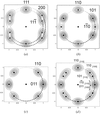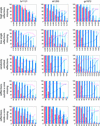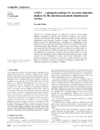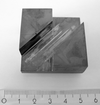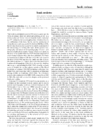issue contents
June 2007 issue

Cover illustration: Molecular electrostatic potential of thymidine mapped on the charge density isosurface at 0.5 e Å-3 using MolIso. Courtesy of C. B. Huebschle & P. Luger [J. Appl. Cryst. (2006), 39, 901-904].
research papers
Several problems of working with thick-walled pressure cells in time-of-flight diffraction are considered: optimization of collection time, design of aperture masks and attenuation correction.
Two-dimensional small-angle X-ray scattering of thin films with oriented three-dimensional cubic mesostructures is discussed.
Features extracted from Fourier-transformed crystallization images are used to provide classification variables. The results are combined with a complementary method to classify the images from individual objects within the spatial domain.
The propagation lengths of hard X-ray guided modes are calculated for the case of a periodic multilayer waveguide that makes use of an air clearance as a guiding layer. The influence of the value of reflectivity from a periodic multilayer on the generation of guided modes is discussed in detail.
An indirect two-trace method to determine interfaces between two crystals with a uniquely defined interface plane is proposed. It involves preparation of only one sample surface, instead of the two perpendicular sample surfaces required by the traditional two-trace method.
The temperature-dependent local structure of NaMgF3 perovskite is probed through pair distribution function [G(r)] analysis. In contrast to previous Rietveld structure modelling, it is found that the average Mg—F bond length, corresponding to a ∼2 Å peak in the G(r), increases between 323 and 1123 K.
Existing computational approaches to the calculation of the normal distribution on the rotation group are considered: the Fourier series method, the analytical approach and the particularized Monte Carlo method. For each method examined, the corresponding algorithm is described, example calculations are given and the field of application is summarized.
The possibility to improve an incomplete data set by optimization of a Patterson map by the maximum entropy method is exploited. It is shown that this technique significantly improves the performance of the charge-flipping algorithm applied on an incomplete data set.
The use of a large-active-area flat-panel detector optimized for high-energy X-ray detection to measure X-ray scattering intensities accurately for high-resolution pair distribution function measurements is evaluated, in addition to its suitability for time-resolved studies.
Download citation


Download citation


Two new isomeric 8-hydroxyquinoline derivatives with quinoline groups have been synthesized by Perkin condensation. Their structures were characterized by EI-MS, 1H NMR spectroscopy, elemental analysis and FT–IR spectroscopy; crystal structures were determined by X-ray crystallography.
A grazing-incidence X-ray scattering (GIXS) formula is derived for lamellar structures in substrate-supported thin films. A quantitative analysis of lamellar structures in brush polymer thin films supported on silicon substrates by GIXS measurements is presented, with data analysis using the scattering formula.
Two styles of low-background sample holders for neutron powder diffraction based on inexpensive single-crystal silicon are described as an effective alternative to more conventional null-matrix or null-scattering materials. One uses cylindrical geometry for weakly scattering materials; the other has a large-area flat-plate geometry for highly absorbing samples.
The electron density map of a block copolymer thin film having the hexagonally perforated layer (HPL) structure was directly obtained from the measured grazing-incidence small-angle X-ray scattering (GISAXS) pattern. In addition, X-ray reflectivity analysis has been performed, which when combined with the GISAXS results, provides full details of the HPL structure.
Rubidium titanyl arsenate (RTA) exhibits behaviour consistent with a ferroelectric semiconductor under large applied electric fields, with the development of a non-uniform field in the near-surface region. To confirm aspects of the proposed model, the behaviour of 001 slices of initially single-domain RTA, patterned with periodic Ag electrodes of spacing 38 µm, as for periodic poling in non-linear optics, were investigated using synchrotron X-ray section topography with the electric field applied in situ while under X-ray illumination.
In this paper, the general theory for scattering from laterally heterogeneous vesicles is derived and used in the calculation of the form factor for vesicles with single circular domains. Results are also presented for several other cases such as annular domains.
A new helium-based cryostat is described, which can be adapted on kappa diffractometers equipped with two-dimensional detectors.
The structural properties of an epitaxically grown Fe/Cr/Fe trilayer were studied with anomalous X-ray scattering at two different X-ray energies. Simulations within the frame of the distorted-wave Born approximation allowed a quantitative description of the morphology of each interface.
Open  access
access
 access
accessThe prototype of a universal micromanipulation robot for crystal harvesting is presented, and a robotically harvested trypsin crystal yields a high-resolution structure demonstrating the feasibility of robotic protein crystal harvesting.
Non-trivial X-ray diffraction geometries in reciprocal space for epilayer/substrate systems are presented. By exploiting such diffraction geometries, lattice mismatches, strain grading and anisotropic mosaicity are easily analyzed via ordinary reciprocal-space maps.
The anisotropy of anomalous scattering in brominated nucleobases is investigated. Consequences for anomalous scattering experiments in macromolecular crystallography are discussed.
A unified formulation is proposed for constructing the fundamental zones of Rodrigues–Frank space that specify the geometric features of the misorientations between crystals of any two Laue groups. The use of this space to represent orientation relationships during phase transformation is also addressed.
A novel control of a texture goniometer, which depends on the texture being measured itself, is suggested. The prerequisites of this automated adaptive control is the fast inversion of pole intensities to orientation probabilities in the course of the measurements, and a mathematical method of inversion that does not require a raster of constant step sizes and applies to sharp textures.
short communications
An X-ray method to characterize thin films with unknown crystal structure with specific crystal orientations is presented, in which large volumes of the reciprocal space are mapped by a series of pole-figure measurements using a standard texture goniometer. The data can be used for lattice indexing and texture evaluation and in subsequent steps for a complete structural thin-film characterization.
computer programs
The GEST program has been developed for molecular crystal structure determination from powder diffraction data using a genetic algorithm. In order to make it convenient to run GEST, a friendly graphical user interface has been developed.
A new module for the widely used GULP package has been developed to produce pair distribution functions from phonon information. Details of the theory and implementation are presented, together with results for some sample crystallographic systems (MgO, CaxSr1−xTiO3 and α-cristobalite).
The Visrock program facilitates image analysis in X-ray topography and microdiffraction imaging. It was written primarily for application in serial digital topography (rocking-curve imaging), with additional applications in diffraction-enhanced imaging, computed tomography and other fields of X-ray imaging.
AutoDock, a widely used docking algorithm, has been implemented in a parallel version. A near-linear increase in speed has been observed even with 96 processors, making it possible to carry out high-throughput docking, likely to have a significant impact on structure-based drug design.
The program package ASTRA2.0 for single-crystal structure research using different experimental conditions and radiation of different types (X-rays, neutrons and electrons) is presented. A multipole model up to eighth order is used for electron density analysis.
The main features and potentialities of the computer program suite IL MILIONE are described.
A Windows-based computer program has been developed for the alignments of experimental high-resolution transmission electron microscopy images and for exit-wave reconstruction using these images.
A Python script to analyse the outcome of factorial designs of crystallization experiments is presented.
A package of computer programs intended to facilitate lattice-parameter refinement or strain determination from convergent-beam electron diffraction patterns is described.
The XD preprocessor program InvariomTool presented here allows the automation of the process of invariom and experimental charge density modelling of organic molecules.
laboratory notes
A utility to shade diamond reflections overlapping with sample Bragg spots in high-pressure CCD data is presented. It enables the elimination of false intensities as well as the bias they cause to the integration, leading to more accurate data.
Registering pole figures using an X-ray single-crystal diffractometer equipped with an area detector
A detailed description is given of the procedure of data collection and processing of pole figures from a series of frames collected using an area detector, available at most modern single-crystal diffractometers. This information is extremely useful to characterize polycrystalline materials and to explain their physical properties, which are highly dependent on crystal orientation.
A method to generate linear polarized monochromatic X-rays in the laboratory using a standard X-ray tube is presented.
book reviews
Free 



 journal menu
journal menu









